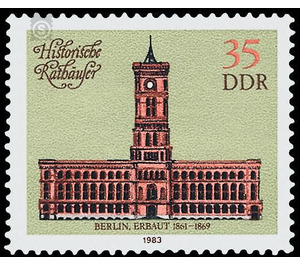Historic town halls - Germany / German Democratic Republic 1983 - 35 Pfennig
Theme: Architecture
| Country | Germany / German Democratic Republic |
| Issue Date | 1983 |
| Face Value | 35.00 |
| Color | multi-colored olive |
| Perforation | K 14 |
| Printing Type | Rotogravure 2 |
| Stamp Type | Postage stamp |
| Item Type | Stamp |
| Chronological Issue Number | 2520 |
| Chronological Chapter | GER-DDR |
| SID | 288248 |
| In 10 Wishlists | |
Historic Town Halls With the pictures of historic town halls, the Ministry of Posts and Telecommunications of the German Democratic Republic publishes four multicolored special postage stamps. Special postage from February 22 to April 21, 1983 Historical town halls 35-Pfennig value: Berlin, capital of the GDR On the site of the medieval town hall from the 13th century was built from 1861 to 1869 today's town hall to a design by Hermann Friedrich Waesemann. Thoughts about the conversion or new building of the town hall occupied the Berlin architects since the early 19th century. In 1817, Karl Friedrich Schinkel produced a series of plans for the renovation of the town hall. After a competition 1857 to 1858 Waesemann received in 1859 the contract for new construction. Ideas from the previous competitions flowed in. Above a granite pedestal, a four-winged building with a square plan and three inner courtyards was built in red clinker (hence the name Rotes Rathaus) in the style of the northern Italian Renaissance. The four-storey building is crowned with a strongly profiled main cornice and attic. Above this, a tall square tower looms slightly behind, which is one of the defining factors for Berlin's urban skyline. The two middle floors are connected by high round-arched windows and give the building a representative appearance. On the balcony parapets of the main floor there is a relief frieze: The so-called "stone choir", consisting of 36 terracotta panels from the history of Berlin from the founding of the city until 1871. The building suffered severe war damage during World War II and was rebuilt from 1950 to 1958 The interiors were largely redesigned.


